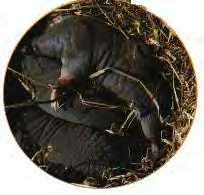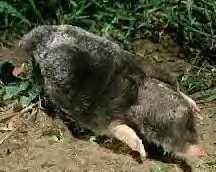|
 The
mole is part of the Talpidae family, order insectivora, and has a pointed
snout, rudimentary eyes, soft thick velvety fur, broad feet and long powerful
claws on the front pair of legs. The
mole is part of the Talpidae family, order insectivora, and has a pointed
snout, rudimentary eyes, soft thick velvety fur, broad feet and long powerful
claws on the front pair of legs.
The
mole, or "little gentleman in velvet" is a worm catcher of astonishing
rapidity and devours his own bodyweight in worms in a short time. He needs
50% of his bodyweight in food per day and can quickly die of starvation.
He eats mainly worms, which he holds in his front paws like a squirrel
and wipes it clean with his claws, but he also eats slugs and snails or
whatever appropriate meal he comes across! In deciduous woods on clay
soil there will be enough worms to feed two moles per acre and he will
not often have to venture above ground from his underground tunnels. Earthworms
fall into their tunnels and he will sense them, catch them and often store
them injured but alive in his larder at the side of an underground run.
Nesting
 The
female mole builds her nest in a football sized chamber lined with dead
leaves and grass. A larger molehill may cover the breeding nest in spring.
The young are born without hair in June, generally about four or five
of them. The curious mounds of earth thrown up by moles (molehills) are
excellent drainage and soil aeration made by mole tunnels but most gardeners
are not so keen! Moles seldom nest in water-logged soil. The tunnels are
not just homes but carefully constructed traps to catch their prey, as
well as kitchen and dining room! Moles often return to the same sites
annually. Enlarged nest chambers are built at the centre of tunnel networks,
in which they weave a ball of dried grass. Elaborate "fortresses"
are built above the surface if the soil is not deep enough for a conventional
nest. The
female mole builds her nest in a football sized chamber lined with dead
leaves and grass. A larger molehill may cover the breeding nest in spring.
The young are born without hair in June, generally about four or five
of them. The curious mounds of earth thrown up by moles (molehills) are
excellent drainage and soil aeration made by mole tunnels but most gardeners
are not so keen! Moles seldom nest in water-logged soil. The tunnels are
not just homes but carefully constructed traps to catch their prey, as
well as kitchen and dining room! Moles often return to the same sites
annually. Enlarged nest chambers are built at the centre of tunnel networks,
in which they weave a ball of dried grass. Elaborate "fortresses"
are built above the surface if the soil is not deep enough for a conventional
nest.
Mole Myths
"Moles
are rodents"
Moles are actually insectivores, not rodents. They
are from the same family as the anteater.
"Moles
are blind"
Moles have extremely tiny eyes that are basically
a thin membrane behind their snout. These "eyes" allow them
only to sense light and little else.
"Moles
are territorial and live alone"
This one is partially true. Moles generally do not
get along with one another. In fact, they will often fight to the death
if another mole infringes upon their territory (obviously this is not
true during mating season).
 Donald
and Lillian Stokes in their book, Animal Tracking and Behaviour 1986,
say: Donald
and Lillian Stokes in their book, Animal Tracking and Behaviour 1986,
say:
"Moles
are believed to remain solitary as adults and avoid contact with other
moles. However, there are at least two exceptions. One occurs in the spring,
when the males start to move around and leave their range in search of
females. They may move about for several weeks, even after all the females
in an area have mated. The other exception is that occasionally some tunnels
are used by several moles; these tunnels are, in a sense, like highways.
This communal use suggests that the social system of moles is more complex
than we think."
"Moles
eat 2 – 3 times their body weight per day"
This claim is greatly exaggerated. Most lab and
field tests will show that while moles do have a voracious appetite, they
only eat up to 70 – 100% of their body weight each day.
"Moles
are eating my plant bulbs and roots"
Moles are almost entirely carnivorous; however,
it is true that moles can indirectly kill plants. They do this in two
ways:
- The
tunnels created by moles will often be used by other small animals.
Voles, in particular, will travel in these tunnels and eat away at roots
and tubers.
- A good location
for grubs and worms is among the roots of a hedge, flower, or other
type of plant. The mole will scrape the dirt away from the roots in
search of food, thereby removing the plants’ source of nourishment.
"Moles
are nocturnal (active only during the night)"
This misconception is usually the result of people
looking out their window in the morning and seeing fresh mole hills. In
fact, moles are not necessarily more or less active at any time during
the day or night. Current research suggests that moles sleep and work
in 4-hour shifts. They are more active during quiet periods, such as early
morning or late in the evening. When they feel vibrations in the ground,
as created from people or pets walking, they will be more likely to
cease their digging.
|

 A
man was in love with a woman who disliked him and wanted nothing
to do with him. He tried in every way to win her favor, but with
no success. At last he grew discouraged and made himself sick
thinking about it.
A
man was in love with a woman who disliked him and wanted nothing
to do with him. He tried in every way to win her favor, but with
no success. At last he grew discouraged and made himself sick
thinking about it.  That
night, burrowing underground to the place where the girl was in
bed asleep, Mole took out her heart. He came back by the same way
and gave the heart to the discouraged man, who couldn't see it even
when it was in his hand.
That
night, burrowing underground to the place where the girl was in
bed asleep, Mole took out her heart. He came back by the same way
and gave the heart to the discouraged man, who couldn't see it even
when it was in his hand. The
mole is part of the Talpidae family, order insectivora, and has a pointed
snout, rudimentary eyes, soft thick velvety fur, broad feet and long powerful
claws on the front pair of legs.
The
mole is part of the Talpidae family, order insectivora, and has a pointed
snout, rudimentary eyes, soft thick velvety fur, broad feet and long powerful
claws on the front pair of legs. The
female mole builds her nest in a football sized chamber lined with dead
leaves and grass. A larger molehill may cover the breeding nest in spring.
The young are born without hair in June, generally about four or five
of them. The curious mounds of earth thrown up by moles (molehills) are
excellent drainage and soil aeration made by mole tunnels but most gardeners
are not so keen! Moles seldom nest in water-logged soil. The tunnels are
not just homes but carefully constructed traps to catch their prey, as
well as kitchen and dining room! Moles often return to the same sites
annually. Enlarged nest chambers are built at the centre of tunnel networks,
in which they weave a ball of dried grass. Elaborate "fortresses"
are built above the surface if the soil is not deep enough for a conventional
nest.
The
female mole builds her nest in a football sized chamber lined with dead
leaves and grass. A larger molehill may cover the breeding nest in spring.
The young are born without hair in June, generally about four or five
of them. The curious mounds of earth thrown up by moles (molehills) are
excellent drainage and soil aeration made by mole tunnels but most gardeners
are not so keen! Moles seldom nest in water-logged soil. The tunnels are
not just homes but carefully constructed traps to catch their prey, as
well as kitchen and dining room! Moles often return to the same sites
annually. Enlarged nest chambers are built at the centre of tunnel networks,
in which they weave a ball of dried grass. Elaborate "fortresses"
are built above the surface if the soil is not deep enough for a conventional
nest. Donald
and Lillian Stokes in their book, Animal Tracking and Behaviour 1986,
say:
Donald
and Lillian Stokes in their book, Animal Tracking and Behaviour 1986,
say: